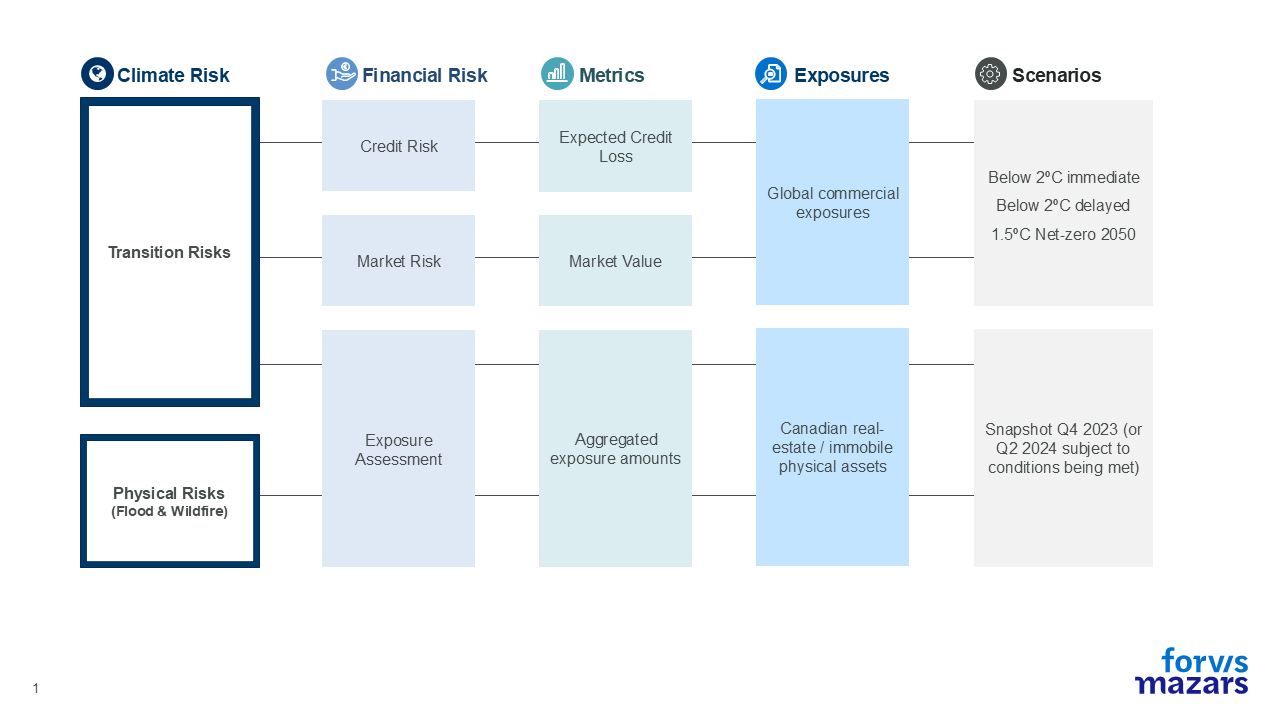
Advancing climate scenario analysis capabilities
Scope of the SCSE
The SCSE is structured along four independent modules summarized below
Documents to submit for the SCSE
Participants are expected to submit the below documents by these timelines
| Document | Document Description | Deadline |
|---|---|---|
| Worksheet for credit risk module | Baseline ECL and Climate Adjusted Lifetime ECL across the different time horizons of in-scope exposures disaggregated by industry, region, asset class, credit quality bucket and weighted average duration | 13 December 2024 |
| Worksheets for market risk module | Climate adjusted market values of in-scope exposures disaggregated by industry and sector | |
| Worksheets for real estate transition risk | Drawn and un-drawn value of in-scope exposures disaggregated by province and source of heating and power (i.e. whether source is fuel or non-fuel) | 24 January 2025 |
| Real estate flood workbook | Total undrawn and exposure amount of the baseline and scenario flood depth disaggregated by region, exposure type, property age and flood bucket | |
| Real estate wildfire risk | Total undrawn and exposure amount of the baseline and scenario Build-Up Index (BUI) and fire season length disaggregated by region, exposure type, property age and BUI bucket | |
| Qualitative questionnaire | Description of any internal climate scenario analysis performed and information on assumptions, challenges and coverage of portfolio for the SCSE exercise |
Leverage the SCSE to develop climate scenario analysis capabilities
1. Sector and location mapping
SCSE requirements
- FIs must accurately map geographic locations and industry sectors in their portfolio that are in scope of the SCSE. OSFI has allowed FIs flexibility to adopt mapping approaches suited to their portfolio and operations.
- As part of the questionnaire, FIs are required to detail their mapping process, including any approximations and assumptions made.
Best practices
Robust governance over the mapping process is essential. FIs should formalize their approach, implement thorough validation controls and ensure key judgments are reviewed by senior management. As the SCSE’s sector classification aligns with OSFI’s climate risk return requirements, the mapping process should not be treated as a one-time task. FIs should update their databases, IT systems and reporting tools to streamline future mapping efforts and automate as much as possible. FIs can also consider implementing centralized mapping tools to facilitate data validation for reporting and ensure consistent classification across different business units.
2. Information on real estate modules
SCSE requirements
· For the real estate assessments, FIs will need data on the locations and energy sources of in-scope exposures.
- Given anticipated gaps in energy source data, OSFI recommends using proxies like Statistics Canada’s data on primary heating systems and energy types.
- When geocoding, FIs may apply approximations and simplifications, particularly for multi-collateral loans and multi-point exposures where pinpointing a single latitude and longitude pair can be challenging given their large footprint.
- It is advisable to utilise tools that efficiently generate geocodes and systematically link them with physical risk metrics for relevant hazards.
- Questionnaire responses should include information on proxies used, geocoding processes, experience with hazard maps and data collected on risk mitigation measures.
Best practices
FIs should enhance their collection of energy consumption and address level information within their internal systems. This information is essential for the SCSE and other analyses such as materiality assessments and finance emissions for mortgage and commercial real estate. FIs can source this information directly from counterparties during onboarding or ongoing due diligence reviews. Additionally, they can leverage on other sources such as publicly available information, third party data providers, databases from government agencies or utility companies. Where relevant real estate information is incomplete, proxies or adjustments would be used and FIs should establish sufficient governance procedures over these measures.
3. Enhancement or development of models and tools
SCSE requirements
- FIs require tools and models to support assessments for the SSE modules. For instance, the credit risk module necessitates calculating climate-adjusted Probability of Default (PD), Loss Given Default (LGD) and ECL across different time horizons.
- In the real estate transition and physical risk modules, FI must determine baseline and scenario physical risk metrics weighted by exposure amounts and then aggregate these according to the granularity required in SCSE workbooks.
Best practices
FIs should implement robust risk management processes, policies and procedures throughout the lifecycle of updated or newly developed models. This includes validation controls to ensure model performance and outputs align with expectations. While adjusting existing models can serve as an initial step towards integrating climate-related risks, FIs should consider how they would incorporate sector-specificities and individual counterparty level data into their modelling. Furthermore, adopting tools that streamline reporting will enable meaningful insights into potential impacts of climate-related risks and easily highlight areas needing management actions.
4. Internal climate scenario analysis framework
SCSE requirements
- In the questionnaire, FIs are expected to describe their internal climate scenario analysis process, identified material gaps in their climate risk assessment and any modifications made after completing the B-15 self-assessment questionnaire.
Best practices
FIs should leverage learnings from the SCSE to develop their internal climate scenario framework. Key components of this framework include: 1/ Define objectives and scope of climate scenario analysis; 2/ Gather data and identify solutions to bridge data gaps; 3/ Design scenarios tailored to institution’s needs; 4/ Adopt suitable assessment approaches, modelling tools and metrics; 5/ Report findings and determine management actions; 6/ Integrate results into risk management, reporting and strategic planning.
How we can help
Our team of experienced professionals deliver pragmatic, tailored solutions to help clients conduct regulatory climate scenario analysis exercises. We also assist in developing climate risk capabilities aligned with regulatory expectations and best practices. Please get in touch if you would like more information or wish to speak with a member of our team.
Want to know more?


